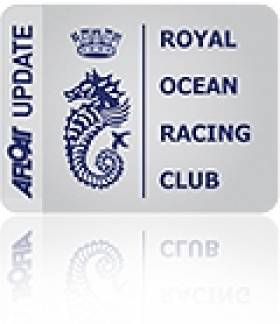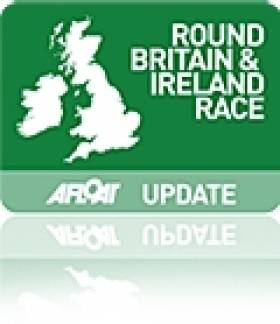Displaying items by tag: Andrew McIrvine
Carrickfergus Navigator Ian Moore Plots Aegir Caribbean Course
On loan from the Oracle America's Cup Team, Northern Ireland ace navigator Ian Moore is the navigator on board the Carbon built 80-footer Aegir for this week's RORC race in the Caribbbean.
Antigua Yacht Club is buzzing with excitement, with two days to go to the start of the 600-mile race around the central Caribbean. Yacht crews are busy at work making final preparations for the Royal Ocean Racing Club's (RORC) Caribbean 600. Falmouth Harbour is an impressive sight with the RORC fleet safely moored up next to the yacht club.
RORC Yacht of the Year ready for battle
Piet Vroon's Ker 46, Tonnerre de Breskens - the RORC 2010 Yacht of the Year - arrived just before dusk on Friday. The delivery crew, all six of whom will also be racing, endured a 1,000 mile beat to Antigua from Jamaica: "This will be our fourth and final event in the Caribbean." Explained Piet Vroon. "This is the first time that I have done this race and it is the main reason that we came to the Caribbean. All of my crew said that this is a race that they want to do and I am very much looking forward to it."
Tonnerre is one of three boats that competed in the Pineapple Cup, the opening rubber of the Atlantic Ocean Racing Series. George David's Rambler 100, Richard Oland's Vela Veloce and Hugo Steinback's Dubois 90, Genuine Risk also competed in the Pineapple Cup which Genuine Risk won on corrected time. Vela Veloce is a Southern Wind 52, which cleaned up in Key West race week in January.
Entries from Australia and 14 other nations
Yachts representing 15 Nations have come to Antigua to compete in the 600-mile spectacular, but none have come as far as Chris Bull's Cookson 50, Jazz. The canting-keel flyer arrived in Antigua on Friday, having made an epic journey bycontainer ship and sail from Australia, after a fantastic performance in the Rolex Sydney Hobart.
"It's been hard work getting the boat here from Australia, but we have done it, which just goes to show it is possible." Commented Boat Captain, Anthony Haines. Jazz's journey started on January 8th from Sydney, Australia to Savannah, Georgia. After which the delivery crew sailed 1400 miles to get Jazz to Antigua on time.
"Ever since the RORC conceived the idea of this race I have wanted to do it," said Chris Bull on he dock in Antigua. "I am also keen to do the Transatlantic Race and try and win the Atlantic Ocean Racing Series which I think is an excellent initiative which the RORC are involved with."
Rock Stars and Corinthian Sailors Rub Shoulders
From Lithuania, the Volvo 60, Ambersail debuts in the Caribbean and counts veteran round the world sailor Magnus Olsen in their crew. Ambersail is well travelled, having competed in last year's Sevenstar Round Britain and Ireland Race and the Rolex Middle Sea Race.
Ondeck's Farr 65, Spirit of Minerva counts British solo-sailor Hannah White amongst the crew: "Effectively there are 10 legs and well over 600 miles of racing in fantastic trade wind conditions which I am sure will be a strong test for navigators and crews in equal measure." Commented Hannah.
Class 40 World Champions on the line
Six Class 40s are expected, possibly more. Tony Lawson's Concise and Gonzalo Botin are past and current Class 40, world champions. Tony Lawson, owner of Concise expects a close duel with Tales: "There is no doubt that the Spanish team will be fast and possibly more suited to lighter conditions, but I am confident that the team on Concise will be fully focused and they are in control of a quick, well prepared boat."
Power and Elegance Combine
RORC Commodore, Andrew McIrvine has chartered the elegant and powerful 154 ft schooner, Windrose of Amsterdam. The crew has taken the magnificent yacht through its paces, spending two days practicing manoeuvres: "It is a very different kind of sailing to my First 40." Commented Andrew McIrvine. "The sheer size of the sails and equipment make for extremely physical work and manoeuvres are far more complex. Communication from front to back is only possible by hand signals. We had some good pressure during our practice session, which confirmed that Windrose is a powerful yacht, literally built for Caribbean sailing."
Navigator's make their Predictions
Brian Benjamin's Carbon Ocean 82, Aegir has been out testing sails and the crew, visiting the top part of the race course all night Friday. Night sailing makes up close to half the time during the race. Boat captain Shreda Duke confirmed that the exercise was very successful in bedding in the crew to their proposed watch-system. Aegir's navigator for the race is Ian Moore on loan from the Oracle America's Cup Team. Moore concurs with Hugh Agnew, ICAP Leopard's navigator, the prediction of stable trade wind sailing but added: "The first key area of the race may well come as night falls. Aegir should be approaching Nevis at dusk and the first really tricky part of the course. The islands of Nevis and St Kitts are high, which will throw out quite a wind shadow through this area; there will be a lot of gear changes in between the lulls and puffs of acceleration. The big decision from a navigator's point of view will be how far off the leeward side of these islands to go."
In Falmouth Harbour, the air temperature is a balmy 27º C and a fair breeze is flowing in from the northeast, meaning that the trade winds are functioning, but it's an ever-changing picture. Read John Burnie's expert summary on the RORC Caribbean 600 web site: http://caribbean600.rorc.org/
100 footers Go Head to Head
ICAP Leopard set the monohull course record in 2009, completing the course in 44 hr 5 min 14 sec and Mike Slade's team believe that they could beat the record, although they may not be the first home. George David's stunning Maxi, Rambler 100 is dockside in Falmouth and are favourites to take line honours. George David has secured the assistance of Ken Read to the afterguard and some of Ken's Puma Volvo Ocean Race crew. It is the first time that these two 100 foot canting keel maxi's have raced each other with ICAP Leopard having taken an interesting strategy and dropped their rating considerably, in a bid to gain handicap honours.
Local Knowledge from Caribbean Entries
Local interest comes from Bernie Evan-Wong who is competing in the race for the third time in his Mumm 36, High Tension. From Guadeloupe there is a Class 40, Territoires Attitudes, skippered by David Ducosson.
34 boats are expected on the start line on February 21st February. The RORC Caribbean 600 web site contains regular updates on the race, blogs from the boats and the progress of the boats, which have trackers, can be followed via the website: http://caribbean600.rorc.org/
RORC and UNCL to Forge New Worldwide Rating
The Royal Ocean Racing Club (RORC) and Union Nationale pour La Course au Large (UNCL), joint owners of the IRC rating rule, have been in discussion with the Offshore Racing Congress (ORC) about the possibility of creating a unified organisation to govern yacht ratings worldwide. This initiative to bring the world offshore rating systems together was endorsed by ISAF following its AGM in 2009 in Korea.
The intention is for RORC/UNCL and ORC to create a joint venture company which would run the existing rules, IRC and ORC and then in time, using the combined knowledge and resources, evolve new rating systems that combine the benefits of IRC and ORC to create fast, fun and seaworthy boats for unified competition all over the world.
Bruno Finzi, Chairman of ORC, working alongside Vice-Chairman Wolfgang Schaefer, are enthusiastic and confident about working with the RORC. "We appreciate the work and friendship with RORC and we believe it is finally time to get back to the IOR era and to the ORC founding spirit, when only one single rule was recognised as 'the international' rule in offshore sailing."
Chris Little, Admiral of the RORC, working with Commodore Andrew McIrvine agree that it is time to bring the development of rating systems under one umbrella.
"We have received strong support from a number of countries and potential owners to develop a rule that will allow us to recreate the international yacht racing circuit and we shall continue to work towards this goal."
Bad Forecast Forces Organisers to Change Direction of Race
At last night's Skipper's Briefing for the Sevenstar Round Britain and Ireland Race, the Royal Ocean Racing Club (RORC) announced a dramatic change to the race. Part of the reason for the change is being blamed on a lack of shelter for boats in trouble on the Irish West coast. There are no Irish entries in this year's race.
Due to a severe weather forecast for the west coast of Ireland for Thursday 26th August, the RORC have decided to reverse the course so that the fleet will race anti-clockwise around Britain and Ireland. The start remains unchanged from the Royal Yacht Squadron line to the east at 14.00. This should give the fleet a fast running start towards the forts in the Solent.
Andrew McIrvine, Commodore of the Royal Ocean Racing Club explains why the club took the decision:
"The reason for changing the course is consideration for all the competitors. We have been monitoring the weather models for the last few days and they are all in agreement that a deep depression will be arriving to the west of Ireland at the same time as most of the fleet will be there. The RORC weather advisor Mike Broughton, believes that this will bring wind speeds of at least 40 knots, possibly as much as 50 knots on the nose. Worse than that, as the wind direction changes over 180º as the low passes through the sea state becomes very confused. Although the boats are very well prepared, these conditions could cause damage and retirements and the west coast of Ireland has very few places offering shelter. By going east about, the boats will avoid the worst of the depression and the confused sea state and will have far more shelter opportunities as there will be several ports that the boats can go into should they decide to do so."
The Sevenstar Round Britain and Ireland Race starts tomorrow at 1400 from the Royal Yacht Squadron Line, Cowes, Isle of Wight, England.
For more information and to follow the fleet via the race trackers go to: http://sevenstar.rorc.org/
































































